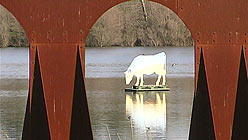During a trip to Europe in 1975, the artist and librarian John Held Jr. found a store in Amsterdam that sold visual rubber stamps. He bought several and began using them in the pen and ink drawings that he was doing at the time. After returning to New York, he discovered that rubber stamps were commonly being used in a burgeoning network of underground artists involved in mail art.
The variety and heterogeneity intrinsic to mail art makes it difficult to define the practice exactly; however, the term generally refers to a range of artworks that are exchanged through the postal services. The act of mailing the artwork is an essential component of the work, which seeks to establish a network or community of individuals for the exchange of objects and ideas. Many mail artists address social and political concerns, including examinations and critiques of the fine art world, its institutions and traditional channels of circulation. Some of the objects exchanged in mail art include postcards created by or modified by artists, nonofficial postage stamps called artistamps, decorated envelopes, found objects, and one of a kind or limited edition artist’s books.
In the story about John Held Jr. in the Spark episode “The Fine Art of Collecting,” Held takes viewers through some of his expansive collection of mail art, one of the most extensive in the world. For more than 25 years, Held has been collecting art sent to him through the mail, and the collection amounts to well over 30,000 pieces. He has since donated part of his collection to various art institutions, including New York’s Museum of Modern Art, the J. Paul Getty Foundation and the Smithsonian’s Archives of American Art, but Held still keeps much of his collection of correspondences.
Since the only way to receive mail art is to produce it and send it to others, at its core mail art is about communication, exchange and the creation of a kind of virtual community of participants. In this sense, mail art anticipates the cyber communities founded on the Internet. It is not surprising, then, that Held and others believe that the Internet has extended the possibilities and scope of mail art. But even as new technologies transform the practice, introducing email lists, message boards and online exhibitions, Held contends that mail art continues in its material, postal form, renewed by and working hand in hand with new means of digital communication.
At the heart of Held’s interest in mail art is the way the art form merges fine art with the experiences of everyday life. With more traditional forms, art objects are exhibited in galleries and museums — places far removed from people’s daily experience. By using the post office as a means of circulating their works, mail artists sidestep the usual means of artistic distribution, effectively turning a regular aspect of daily life — collecting and opening mail — into an opportunity for an artistic encounter.
In this spirit, many artists find similar ways of turning aspects of their everyday life into works of art. Spark talks to Held’s other mail artists friends — like Robert V. Rocola, who has been involved in this art form since his army days in the ’60s, and Diana Mars, who has been hosting a dinner every week for 10 years, turning the meal into a means of generating art objects. Mars, who is also involved in mail art, produces materials relating to her dinners each week, including invitations, artist’s postage stamps, photographs, a guest book and other kinds of documentation of the event. The dinners themselves are also catalysts for collective performances, which are then also documented by Mars.
Exchange your own art with mail artists:
John Held Jr.
P.O. Box 410837
San Francisco, CA 94141
Robert V. Rocola
740 Dutton Ave.
San Leandro, CA 94577
Array
Resources
- Array
- Array
- Array
- Array

